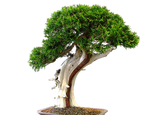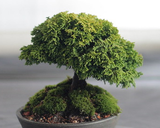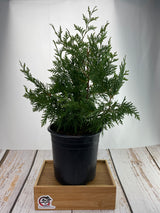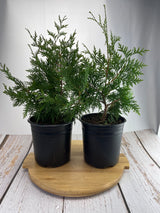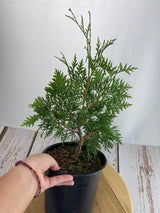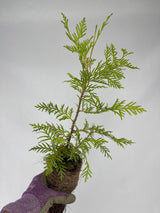White Cedar
Eastern White Cedar: (Thuja Occidentalis) belongs to the cypress family and is a slow-growing tree or shrub that develops very distinct deadwood and makes some of the most striking Bonsai specimens. They are native to the northern hemisphere and are very hardy trees that don't mind being potted up and react well to Bonsai training techniques and root pruning. Eastern White Cedar can be placed in full sun and although they are very frost-hardy, being planted in a container means they will need winter protection from extreme cold. The only real challenge with the Eastern White Cedar is that they need light when winterizing, so planting them in the ground in early fall or placing them in a cool location that gets sunlight during the winter months is recommended.
BONSAI CARE
The Eastern White Cedar can be taken out to the garden or balcony when the first signs of spring appear. They will thrive in full sun, although offering them some mid-day shade during extreme heat would be better. Misting your Eastern White Cedar on warm days will promote healthy needles and growth.
Watering:
- Eastern White Cedars are often found near bodies of water, and the root ball should never be allowed to dry out. To better regulate moisture around the root ball, planting them with sphagnum moss around the root ball will ensure the roots stay moist with standing water which can cause root rot.
- During the growing season, ensure water before the soil dries out.
- During the winter, light watering is recommended every time the soil starts to dry out.
Training:
- Pruning: Eastern White Cedar's new shoots can be pinched back to promote ramification whenever they grow too long. Eastern White Cedars bud back very well, so they can be pruned down to the hardwood during a heavy pruning. Heavy pruning should be done in late fall.
- Wiring: Eastern White Cedar can be wired year-round.
- Repotting: Eastern White Cedar in development need to be repotted every 2-3 years in a good draining soil mix like an even mixture of Akadama, Pumice and Lava Rock. Mature Eastern White Cedar can be repotted at longer intervals. Another good mix for the Eastern White Cedar is 50% Horticultural Clay, 25% Pumice and 25% Pine Bark Fines. This mix is excellent for promoting development.
PRODUCT DETAILS
YOUNG: 8"-12" tall, comes in a 6" grower's pot.
These are not seeds - But an Actual Living Bonsai Tree.
Please see our Choosing a Bonsai page for the age and dimensions regarding the different stages of our Bonsai (Baby, Young, & Mature).







